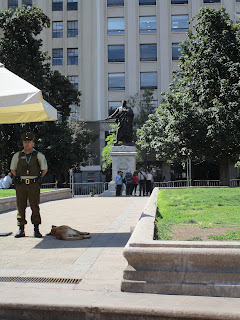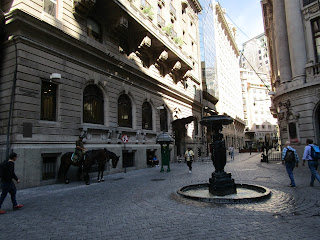 |
| Fuente Alemana in Parque Forestal, a gift from the people of Germany (Alemana in Spanish) to the people of Chile. Just for being themselves. |
Add Santiago de Chile to the list of cities where there are free walking tours. You walk the tour and you tip the tour guide what you think is fair. Sounds socialistic. We will get to that on our walking tour.
First of all, before I begin, let me say this: I was lied to about Santiago de Chile. What you read about Santiago on the internets? Lies. Lies. Lies. Yeah.
This is the Museo de Artes Visuales, or MAVI, or, en ingles, the Museum of Visual Arts. It's right next door to my hotel. I like the entrance.
Getting back to the lies. On the internets, everyone says that Santiago is dangerous, not safe at all, and there's nothing to do. So I listened to what everyone said and booked just two nights in this city. I am kicking myself (not literally) (I'm not flexible enough to do that) that I did not schedule more time here. It's a beautiful city. Friendly. Clean (except for graffiti everywhere) (but no litter anywhere ever). Relatively inexpensive. This part of the city is quite safe. And there is a lot more to do here than my short amount of time here would allow.
Anyway: Free Walking Tour is today's topic. And to start the free walking tour, I was to meet the tour guide in the Plaza de Armas. Not here, where this fountain is.
And not in front of the cerrado Museo Histórico Nacional which, as we learned yesterday, is closed due to a strike of museum workers. There is a new black banner in front with some feel-good message about being closed for the good of all. Well, how good can it be for me when I've got just two days in town and the museum workers are on strike both days? What about me? What's in it for me?
Let's begin the tour, shall we?
The tour properly began on the north side of Plaza de Armas, with the city maps embedded into the pavement. This map is from the early years of Spanish conquest. This child is standing in the middle of Mapocho River. In crocs.
The city was built alongside the river, but not because the river is navigable. It's not. It's shallow. Hence the child being able to walk in the river in crocs. But it is a water supply in an otherwise desert climate, so that river water was valuable, even if it was not an early highway in and out of town.
We went into the cathedral, which I did yesterday, and started walking west.
To the Cámara de Diputados, or "Chamber of Deputies." It's now a state government office, but it has served many other governmental purposes over the years.
Case in point: the old city gallows are on the property. You have been warned.
Next we come to Plaza de La Constitución and, across from it, Palacio de La Moneda.
The Palacio de La Moneda, again a governmental building that has been repurposed multiple times throughout its history, now serves as the offices (but not the home) of the Chilean president.
Recognize him? Clue:
Chile just marked the 50th anniversary of the coup that deposed this gentleman as president of Chile and replaced him with the only military dictatorship in Chilean history, that of Agosto Pinochet. This is Salvador Allende. Both he and Pinochet are still divisive figures in Chile, both still have their supporters in-country, although there are no statues of Pinochet anywhere that I know of. Allende was an avowed socialist, hence the reference to socialism several paragraphs back. He may have been farther left than that. We don't know for certain. He may have been plotting to take over the government permanently. We don't know that either, although we do know that was a justification given for the coup at the time. But Allende's star is on the rise in Chile right now, with a left-of-center government having been recently elected.



























No comments:
Post a Comment